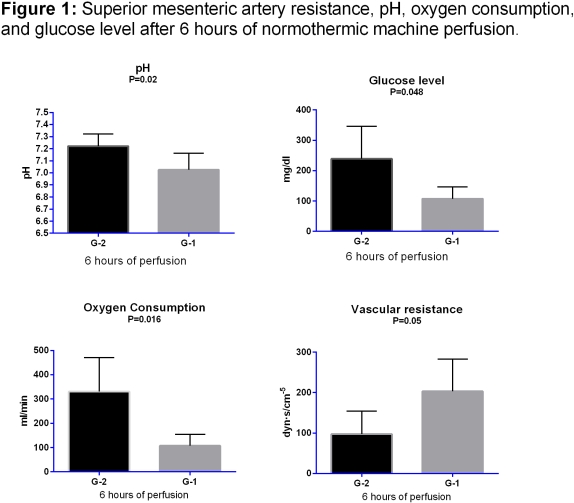Normothermic Ex-Vivo Perfusion of the Intestine: The Introduction of an Innovative Physiologic Model with Novel Biomarkers.
General Surgery, Transplant Center, Cleveland Clinic Foundation, Cleveland, OH.
Meeting: 2016 American Transplant Congress
Abstract number: 553
Keywords: Graft survival, Intestinal transplantation, Ischemia, Preservation
Session Information
Session Name: Concurrent Session: Small Bowel Transplantation
Session Type: Concurrent Session
Date: Tuesday, June 14, 2016
Session Time: 4:30pm-6:00pm
 Presentation Time: 4:42pm-4:54pm
Presentation Time: 4:42pm-4:54pm
Location: Room 102
Purpose: Ischemia reperfusion injury is a major risk factor for short and long-term functional survival after intestinal transplantation. Normothermic machine perfusion is an emerging biotechnology designed to prevent the injury associated with cold storage. This study is the first to describe an experimental model of normothermic ex-vivo perfusion of the intestine. Such an innovative approach is critical for the further improvement in the clinical outcome after transplantation of such a uniquely vulnerable hollow organ.
Methods: The intestine of 10 cardiac death pigs were retrieved, flushed with UW solution, and perfused using washed pig RBCs based colloid solution with Hct value of 10-15 % at 37[deg]C for 6-12h. The perfusion circuit consisted of pulsatile pump, heat exchanger, oxygenator, and organ basin. The superior mesenteric artery was cannulated with free drainage of the vein. Mean arterial pressure was 80-100 mmHg with a flow of 0.010-0.014 L/min/kg. Peptide based elemental formula was used for luminal nutrition. The perfusate was analyzed for pH, PO2, PCO2, glucose.
Results: Four intestines were used to establish the model (G-1) and the remaining six constitute the study group (G-2). The warm and cold ischemia time, 30 to 58min and 90 to 360min, respectively. G-2 showed more active peristalsis compared to G-1 with minimal edema and better perfusion indices. Vascular resistance was significantly (P=0.05) lower (97 ± 25 vs 203 ± 40 dyn[middot]s/cm5) with higher (P=0.02) pH (7.22 ± 0.04 vs 7.0 ± 0.06) and better (P=0.01) O2 consumption (330 ± 57 vs 107 ± 23 ml/min). Interestingly, the enterocyte glucose production was significantly (P=0.04) higher in G-2 compared to G-1 (293 ± 43.8 vs 107 ± 19.3 mg/dl)  .
.
Conclusion:The technical feasibility of intestinal normothermic ex-vivo perfusion was demonstrated and the physio-metabolic principals were successfully established. The perfusate glucose level is unprecedented reliable bioviability marker. Accordingly, further experimental and future clinical trials are warranted.
CITATION INFORMATION: Soliman B, Okamoto T, Quintini C, Liu Q, Fujiki M, Khanna A, Hashimoto K, Fung J, Abu-Elmagd K. Normothermic Ex-Vivo Perfusion of the Intestine: The Introduction of an Innovative Physiologic Model with Novel Biomarkers. Am J Transplant. 2016;16 (suppl 3).
To cite this abstract in AMA style:
Soliman B, Okamoto T, Quintini C, Liu Q, Fujiki M, Khanna A, Hashimoto K, Fung J, Abu-Elmagd K. Normothermic Ex-Vivo Perfusion of the Intestine: The Introduction of an Innovative Physiologic Model with Novel Biomarkers. [abstract]. Am J Transplant. 2016; 16 (suppl 3). https://atcmeetingabstracts.com/abstract/normothermic-ex-vivo-perfusion-of-the-intestine-the-introduction-of-an-innovative-physiologic-model-with-novel-biomarkers/. Accessed December 30, 2025.« Back to 2016 American Transplant Congress
